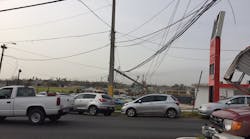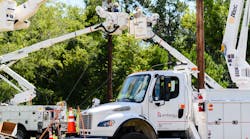Smart grids and microgrids are trendy in the transmission and distribution markets these days. But in the Caribbean, island nations have been operating their own distributed energy and microgrids for a long time. Hurricane season is here, recalling the lessons learned in decades of work performed in the islands in power delivery, from hurricane to emergency recovery and disaster management to studying the effects of renewable energy.
Violent storms and the havoc they wreak on power generation and distribution is a way of life in the Caribbean. Hurricane season hits from August through November, typically. During the past 20 years, including 2017’s Harvey, Irma and Maria, 18 hurricanes have hit the U.S., most of them affecting Caribbean islands.
Some of the places we have worked include Puerto Rico, the Dominican Republic, Grenada, St. Kitts and Nevis, Turks and Caicos Islands, St. Lucia and St. Vincent. The massive Hurricane Irma passed directly over the low-lying Turks and Caicos Islands, causing what the government reported as “catastrophic damage” that included the island’s power systems. Roofs were torn off; cars overturned and trees broken in half or de-limbed.
Hundreds of thousands of Puerto Rico’s utility customers, or about 70 percent, were left without power in Irma’s wake. Puerto Rico’s government-owned power company warned residents through public media that electricity could be out for a week island-wide and up to six months in some places. And right after Irma, Maria struck, again smashing Turks and Caicos along with other islands. Maria took direct aim at beleaguered Puerto Rico, with the hurricane’s eye passing directly over it, destroying property, more of the island’s power grid and even 95 percent of the wireless cell sites.
U.S. crews are rushing to Puerto Rico’s assistance, but they will face challenges unique to the islands. It takes longer for materials to be imported, particularly utility poles. Utilities usually don’t have enough spare parts. Flooding – Maria dumped 40 inches on Puerto Rico – damages at-grade and underground equipment and facilities. The power grid must be rebuilt and tested, not a simple task.
As part of a U.S. Agency for International Development project, Stanley Consultants performed an emergency recovery and disaster management program for St. Kitts and Nevis, two West Indies islands that are frequently impacted by hurricanes. We recommended upgrades for stronger conductors and poles, for example, to withstand 180-mph winds. We looked at load projections and suggested improvements, including new overhead distribution and transmission equipment for the system that ringed the islands.
Common issues
Load forecasting is typically a difficult task in the islands. Working in association with the utility staff, we define what the historical electrical load has been and estimate what will be needed during the next decade; what type of resorts will be built or new businesses added. We define the criteria for necessary improvements and the associated costs. For example, what are the acceptable voltage and conductor loading levels?
We anticipate contingencies and how to respond to them, such as a mistakenly dug-up underground line. Cable is often torn up in numerous locations to locate and repair faults. One client had to cut the cable to get a clean site to test for fault locations. In the case of a fault, should staff be sent out to restore some service with switches, or is it acceptable to wait for the line to be repaired? With the better systems, outages of more than 20 minutes are not acceptable, although an underground fault could last several days if it is not looped. Some customers have diesel-powered back-up generation, which alleviates some of the immediate concern.
We have performed numerous protective coordination studies on the islands. Plant and distribution system arc flash studies are also a common task. Almost all distribution systems operate radially, rather than looped. Some islands employ sophisticated digital relays that will detect and open for faults. It is not unusual to find older electromechanical relays installed as well. However, there is not always a means to back feed circuits to limit the outages. In that case, a fault causes everyone on the feeder to lose power.
One common problem we have encountered over the years is grounding at power plants. It’s not unusual to see an island system that was built 60 years ago, and added to over time, and grounding consistency can sometimes suffer. Publicly owned systems can be poorly maintained, while many privately owned ones, such as on Turks and Caicos, are first class.
A typical problem is numerous single line to ground faults that tend to trip back at the generating plant, due to either a lack of protection coordination in the system or system ground/neutral connections that cause unintended relay operations or over voltages.
On St. Kitts, most non-storm related outages were caused by sugar cane field fires and old conductors breaking. Overhead lines snap because of age and corrosion. Salt air wind caused corrosion was especially bad on the northeast side of the island, where there are constant sea breezes. Bi-metal connectors on copper to aluminum lines are subject to corrosion. Aluminum alloy conductors fare better in the environment.
Although outages are normally repaired within 24 hours, it takes longer after a hurricane. Residents must be warned to stay away from downed or lower hanging lines after a storm. Numerous wooden poles – they are the most commonly used because metal poles are more susceptible to salt corrosion – are typically leaning, especially on angle structures. This is true in cases where the guy wires have been cut, or where the guy leads are short and the poles have sunk due to vertical loading under heavy winds, or caused by adding other attachments or equipment.
Construction
Adding to the consistent funding issues, island nations and private utilities encounter high shipping prices for poles and equipment. With that in mind, one client was considering developing a concrete batch plant to construct concrete poles.
Labor can be another challenge. While local utilities have maintenance crews, contract labor must be brought in to build new, larger facilities. Detailed historical information and up-to-date, reliable drawings of power generation and distribution systems can be difficult to obtain. Projects often include a system review to determine how the systems are connected and operated. In one location, our engineers spent days searching boxed paper records damp from hurricane damage. Local staffs have proven to be good sources of information; a lot of the data that doesn’t appear on a drawing is remembered by staff members.
Soils are often volcanic or limestone, swampy or sandy. These soils can be challenging for setting poles, anchors and underground installations. Sometimes the holes must be overexcavated due to rocks. In sandy or swampy areas, a typical technique would be to insert oil barrels into the pole holes to prevent the hole from caving in.
Renewables and the future
Living with storms is a way of life in the Caribbean and will never go away. But the emphasis on the tourism industry brings with it more sophisticated investment in power infrastructure. Renewables are a part of that.
On Dominica, Stanley Consultants performed a system impact study of a 225 kW wind turbine at Rosalie Bay Resort. The study included analysis and provided recommendations of acceptable voltage levels and frequency at the interconnect point, evaluation of voltage flicker, generated harmonics and power factor, among other issues. We conducted a similar renewable impact study on Grenada, home to more than 100,000 residents and a popular and growing vacation destination. A decade earlier, our engineers created a system model of generation, transmission and distribution networks. Most of the renewable efforts on the island are still in the planning stage, but we see it as a part of the future for Grenada and the Caribbean overall.
The question for the region is whether island nations and provinces can wean themselves from diesel power generation. Eventually they can, but will have to reinvest electricity revenues back into the generation and grid, instead of using electricity revenue for other purposes.


